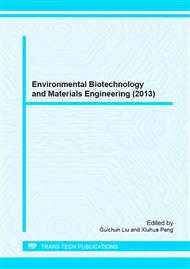p.263
p.268
p.274
p.280
p.286
p.291
p.296
p.303
p.309
COD Removal from Actual Coking Wastewater in a Granular Bio-Film Reactor
Abstract:
To strengthen the COD removal from actual coking wastewater, a lab-scale granular bio-film reactor was continuously operated at three stages for about 9 months: anaerobic vs. micro-aerobic (over 2 months), with and without supplement of bicarbonate (over 2 months), and with and without supplement of diatomite (about 4 months).Compared with anaerobic condition, the micro-aerobic operation could strengthen COD removal in the actual coking wastewater and increase COD removal efficiency from 21.4% to 36.4%. At micro-aerobic operation conditions, the supplement of 3g.Linfluent-1 bicarbonate could distinctly increase COD average removal efficiency from 32.9% to 65.3%, and the supplement of 6g·L-1·d-1 diatomite could significantly increase COD average removal efficiency from 33.1% to 78.1%. The supplement of bicarbonate or diatomite for the granular bio-film reactor must be an effective way for the treatment of actual coking wastewater.
Info:
Periodical:
Pages:
286-290
Citation:
Online since:
September 2013
Authors:
Price:
Сopyright:
© 2013 Trans Tech Publications Ltd. All Rights Reserved
Share:
Citation:


